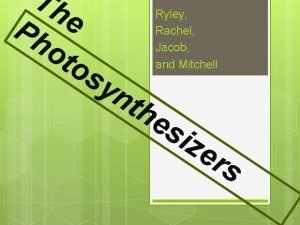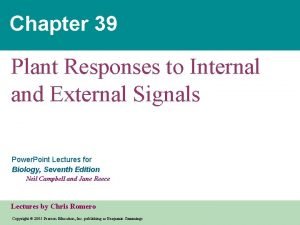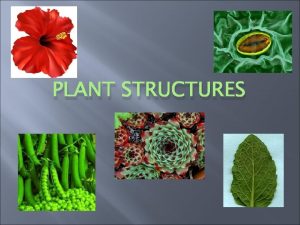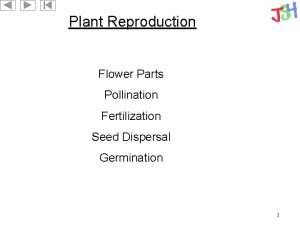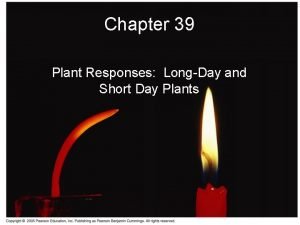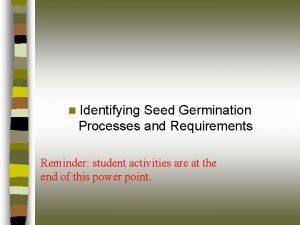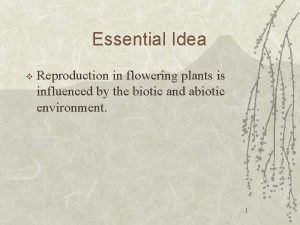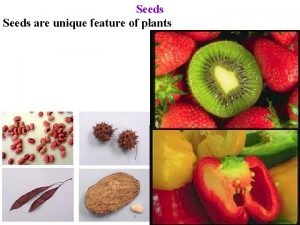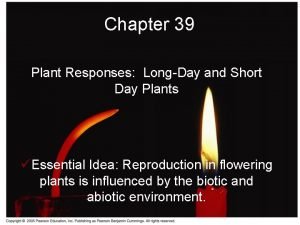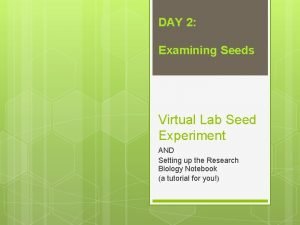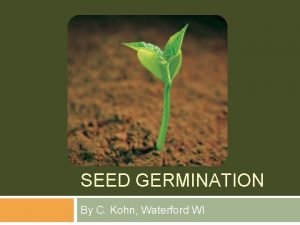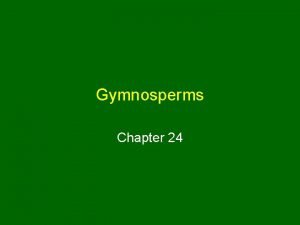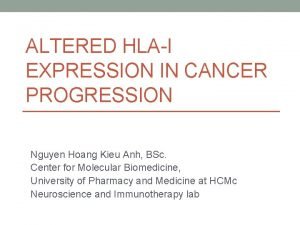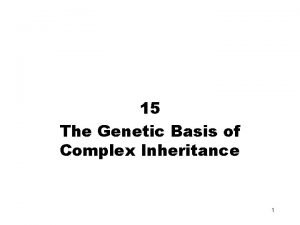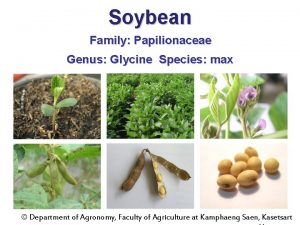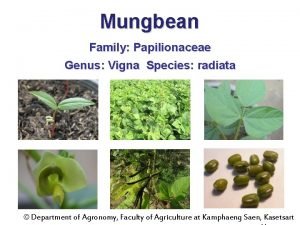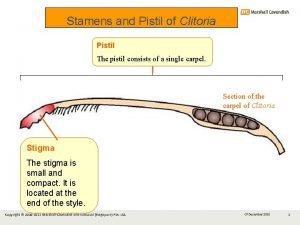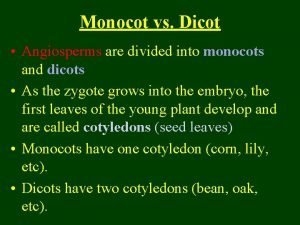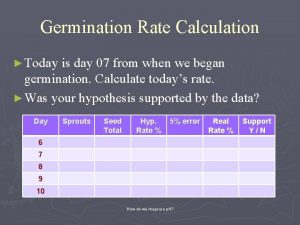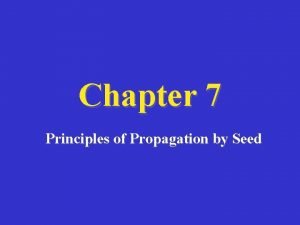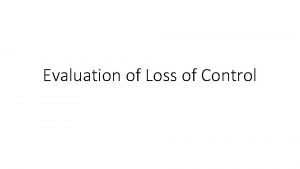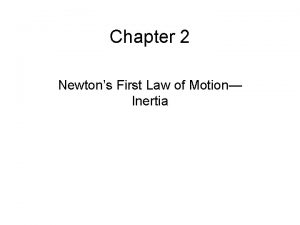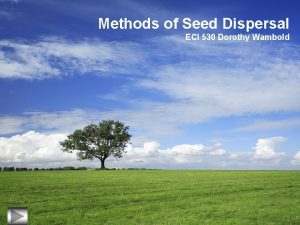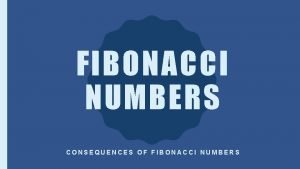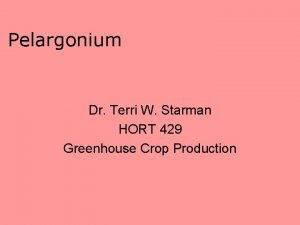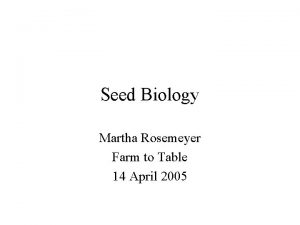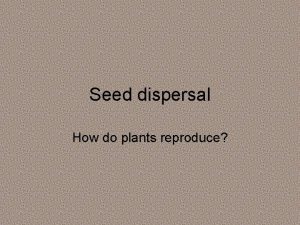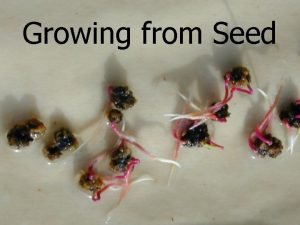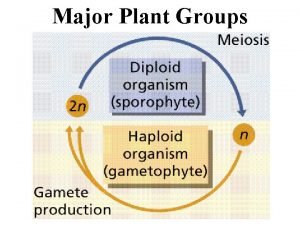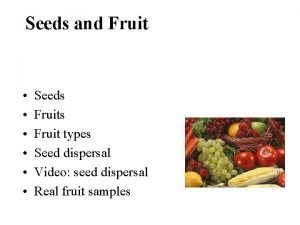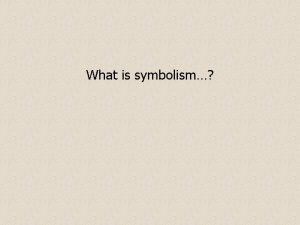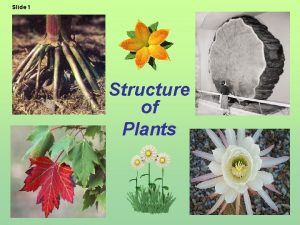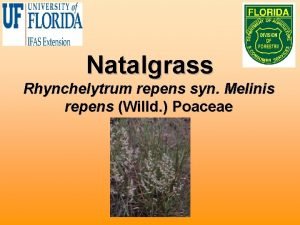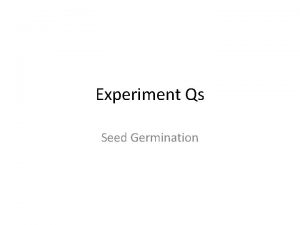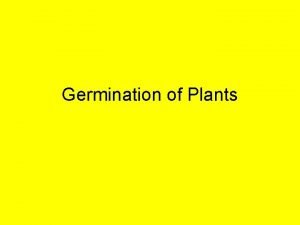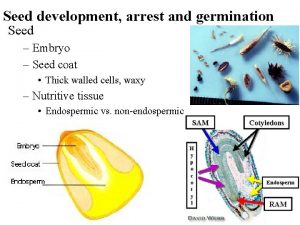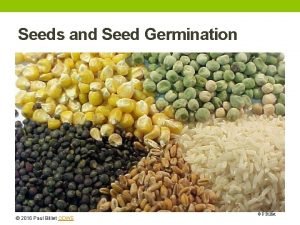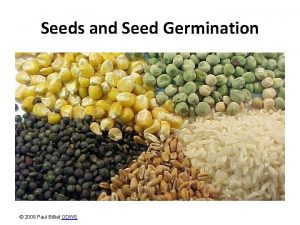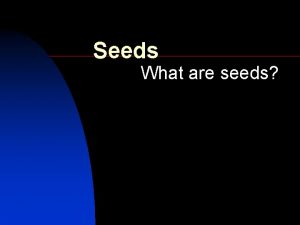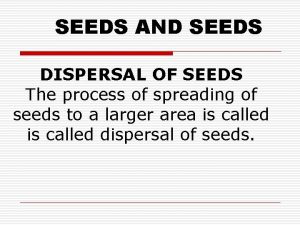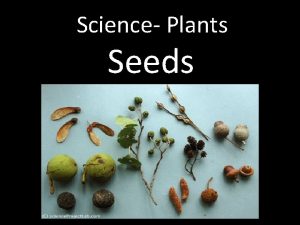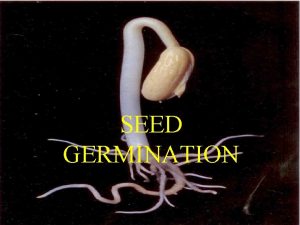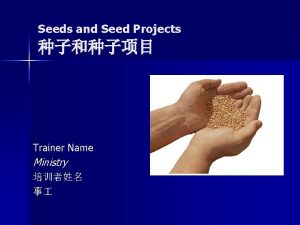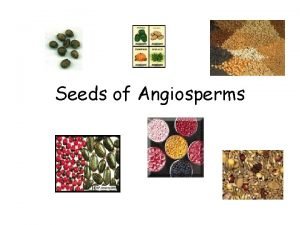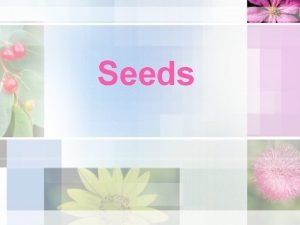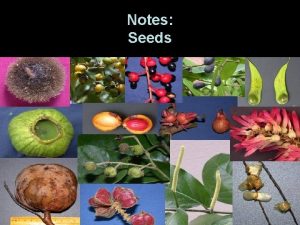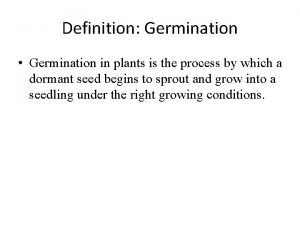Seed germination Seeds remain dormant until sense appropriate









































































- Slides: 73

Seed germination Seeds remain dormant until sense appropriate conditions: • Many require light: says that they will soon be able to photosynthesize: often small seeds with few reserves • Hormones can also trigger (or stop) germination • ABA blocks it • GA stimulates it

Seed germination Germination is a two step process • Imbibition is purely physical: seed swells as it absorbs water until testa pops. Even dead seeds do it. • Next embryo must start metabolism and cell elongation • This part is sensitive to the environment, esp T & p. O 2

Vegetative growth Once radicle has emerged, vegetative growth begins • Juvenile plants in light undergo photomorphogenesis • Juvenile plants in dark undergo skotomorphogenesis • Seek light: elongate hypocotyl, don’t unfold cotyledons

Vegetative growth Once radicle has emerged, vegetative growth begins • Add new leaves @ SAM in response to auxin gradients • Roots grow down seeking water & nutrients • 1˚ (taproot) anchors plant • 2˚ roots absorb nutrients • Continue to add cells by divisions @ RAM

Transition to Flowering Adults are competent to flower, but need correct signals Very complex process! Can be affected by: • Daylength • T (esp Cold) • Water stress • Nutrition • Hormones • Age

Light regulation of Plant Development Plants use light as food and information Use information to control development

Light regulation of Plant Development • Germination • Morphogenesis • Sun/shade & shade avoidance • Flowering • Senescence

Light regulation of growth Plants sense 1. Light quantity 2. Light quality (colors) 3. Light duration 4. Direction it comes from Have photoreceptors that sense specific wavelengths

Light regulation of growth Duration = photoperiodism (Garner and Allard, 1920) Maryland Mammoth tobacco flowers in the S but not in N = short-day plant (SDP) Measures night! 30" flashes during night stop flowers LDP plants such as Arabidopsis need long days to flower SDP flower in fall, LDP flower in spring, neutral flower when ready

Light regulation of growth Measures night! 30" flashes during night stop flowers LDP plants such as Arabidopsis need long days to flower SDP flower in fall, LDP flower in spring, neutral flower when ready Next : color matters! Red light works best for flowering

Phytochrome Next : color matters! Red light (666 nm)works best for flowering & for germination of many seeds! But, Darwin showed blue works best for phototropism! Different photoreceptor!

Phytochrome But, Darwin showed blue works best for phototropism! Different photoreceptor! Red light (666 nm) promotes germination Far red light (>700 nm) blocks germination

Phytochrome Red light (666 nm) promotes germination Far red light (>700 nm) blocks germination After alternate R/FR flashes last flash decides outcome

Phytochrome Red light (666 nm) promotes germination Far red light (>700 nm) blocks germination After alternate R/FR flashes last flash decides outcome Seeds don't want to germinate in the shade!

Phytochrome Red light (666 nm) promotes germination Far red light (>700 nm) blocks germination After alternate R/FR color of final flash decides outcome Seeds don't want to germinate in the shade! Pigment is photoreversible

Phytochrome Red light (666 nm) promotes germination Far red light (730 nm) blocks germination After alternate R/FR color of final flash decides outcome Pigment is photoreversible! -> helped purify it! Looked for pigment that absorbs first at 666 nm, then 730

Phytochrome Red light (666 nm) promotes germination Far red light (730 nm) blocks germination After alternate R/FR color of final flash decides outcome Pigment is photoreversible! -> helped purify it! Looked for pigment that absorbs first at 666 nm, then 730

Phytochrome Red light (666 nm) promotes germination Far red light (730 nm) blocks germination After alternate R/FR color of final flash decides outcome Pigment is photoreversible! -> helped purify it! Looked for pigment that absorbs first at 666 nm, then 730 Made as inactive cytoplasmic Pr that absorbs at 666 nm

Phytochrome Made as inactive cytoplasmic Pr that absorbs at 666 nm or in blue Converts to active Pfr that absorbs far red (730 nm)

Phytochrome Made as inactive cytoplasmic Pr that absorbs at 666 nm or in blue Converts to active Pfr that absorbs far red (730 nm) 97% of Pfr is converted back to Pr by far red light

Phytochrome Made as inactive cytoplasmic Pr that absorbs at 666 nm or in blue Converts to active Pfr that absorbs far red (730 nm) 97% of Pfr is converted back to Pr by far red light Also slowly reverts in dark

Phytochrome Made as inactive cytoplasmic Pr that absorbs at 666 nm or in blue Converts to active Pfr that absorbs far red (730 nm) 97% of Pfr is converted back to Pr by far red light Also slowly reverts in dark: how plants sense night length

Types of Phytochrome Responses Two categories based on speed 1. Rapid biochemical events 2. Morphological changes

Types of Phytochrome Responses Two categories based on speed 1. Rapid biochemical events 2. Morphological changes Lag time also varies from minutes to weeks

Types of Phytochrome Responses Two categories based on speed 1. Rapid biochemical events 2. Morphological changes Lag time also varies from minutes to weeks: numbers of steps after Pfr vary

Types of Phytochrome Responses Lag time also varies from minutes to weeks: numbers of steps after Pfr vary "Escape time" until a response can no longer be reversed by FR also varies

Types of Phytochrome Responses Lag time also varies from minutes to weeks: numbers of steps after Pfr vary "Escape time" until a response can no longer be reversed by FR also varies: time taken for Pfr to do its job Conclusions: phytochrome acts on many processes in many ways

Types of Phytochrome Responses Two categories based on speed 3 classes based on fluence (amount of light needed) 1. VLF: induced by 0. 1 nmol/m-2 , saturate @ 50 nmol/m-2

Types of Phytochrome Responses Two categories based on speed 3 classes based on fluence (amount of light needed) 1. VLF: induced by 0. 1 nmol/m-2 , saturate @ 50 nmol/m-2 • Changes 0. 02% of Pr to Pfr

Types of Phytochrome Responses 3 classes based on fluence (amount of light needed) 1. VLF: induced by 0. 1 nmol/m-2 , saturate @ 50 nmol/m-2 • Changes 0. 02% of Pr to Pfr • Are not FR-reversible!

Types of Phytochrome Responses 3 classes based on fluence (amount of light needed) 1. VLF: induced by 0. 1 nmol/m-2 , saturate @ 50 nmol/m-2 • Changes 0. 02% of Pr to Pfr • Are not FR-reversible! But action spectrum same as Pr

Types of Phytochrome Responses 3 classes based on fluence (amount of light needed) 1. VLF: induced by 0. 1 nmol/m-2 , saturate @ 50 nmol/m-2 • Changes 0. 02% of Pr to Pfr • Are not FR-reversible! But action spectrum same as Pr • Induced by FR!

Types of Phytochrome Responses 3 classes based on fluence (amount of light needed) 1. VLF: induced by 0. 1 nmol/m-2 , saturate @ 50 nmol/m-2 • Changes 0. 02% of Pr to Pfr • Are not FR-reversible! But action spectrum same as Pr • Induced by FR! Obey law of reciprocity: 1 nmol/m-2 x 100 s = 100 nmol/m-2 x 1 sec

Types of Phytochrome Responses 3 classes based on fluence (amount of light needed) 1. VLF: induced by 0. 1 nmol/m-2 , saturate @ 50 nmol/m-2 • Changes 0. 02% of Pr to Pfr • Are not FR-reversible! But action spectrum same as Pr • Induced by FR! Obey law of reciprocity: 1 nmol/m-2 x 100 s = 100 nmol/m-2 x 1 sec 1. Examples: Cab gene 2. induction, oat 3. coleoptile growth

Types of Phytochrome Responses 3 classes based on fluence (amount of light needed) 1. VLF: induced by 0. 1 nmol/m-2 , saturate @ 50 nmol/m-2 • Changes 0. 02% of Pr to Pfr • Are not FR-reversible! But action spectrum same as Pr • Induced by FR! Obey law of reciprocity: 1 nmol/m-2 x 100 s = 100 nmol/m-2 x 1 sec 1. Examples: Cab gene 2. induction, oat 3. coleoptile growth 4. 2. LF: induced by 5. 1 µmol/m-2, saturate @ 6. 1000 µmol/m-2

Types of Phytochrome Responses 3 classes based on fluence (amount of light needed) 1. VLF: induced by 0. 1 nmol/m-2 , saturate @ 50 nmol/m-2 2. LF: induced by 1 µmol/m-2, saturate @ 1000 µmol/m-2 Are FR-reversible!

Types of Phytochrome Responses 3 classes based on fluence (amount of light needed) 1. VLF: induced by 0. 1 nmol/m-2 , saturate @ 50 nmol/m-2 2. LF: induced by 1 µmol/m-2, saturate @ 1000 µmol/m-2 Are FR-reversible! Need > 3% Pfr

Types of Phytochrome Responses 3 classes based on fluence (amount of light needed) 1. VLF: induced by 0. 1 nmol/m-2 , saturate @ 50 nmol/m-2 2. LF: induced by 1 µmol/m-2, saturate @ 1000 µmol/m-2 Are FR-reversible! Need > 3% Pfr Obey law of reciprocity

Types of Phytochrome Responses 3 classes based on fluence (amount of light needed) 1. VLF: induced by 0. 1 nmol/m-2 , saturate @ 50 nmol/m-2 2. LF: induced by 1 µmol/m-2, saturate @ 1000 µmol/m-2 Are FR-reversible! Need > 3% Pfr Obey law of reciprocity Examples : Lettuce seed Germination, mustard photomorphogenesis, inhibits flowering in SDP

Types of Phytochrome Responses 3 classes based on fluence (amount of light needed) 1. VLF: induced by 0. 1 nmol/m-2 , saturate @ 50 nmol/m-2 2. LF: induced by 1 µmol/m-2, saturate @ 1000 µmol/m-2 Are FR-reversible! Need > 3% Pfr Obey law of reciprocity Examples : Lettuce seed Germination, mustard photomorphogenesis, inhibits flowering in SDP 3. HIR: require prolonged exposure to higher fluence

Types of Phytochrome Responses 3 classes based on fluence (amount of light needed) 1. VLF: induced by 0. 1 nmol/m-2 , saturate @ 50 nmol/m-2 2. LF: induced by 1 µmol/m-2, saturate @ 1000 µmol/m-2 3. HIR: require prolonged exposure to higher fluence Effect is proportional to Fluence

Types of Phytochrome Responses 3 classes based on fluence (amount of light needed) 1. VLF: induced by 0. 1 nmol/m-2 , saturate @ 50 nmol/m-2 2. LF: induced by 1 µmol/m-2, saturate @ 1000 µmol/m-2 3. HIR: require prolonged exposure to higher fluence Effect is proportional to Fluence Disobey law of reciprocity Are not FR-reversible!

Types of Phytochrome Responses 3 classes based on fluence (amount of light needed) 1. VLF: induced by 0. 1 nmol/m-2 , saturate @ 50 nmol/m-2 2. LF: induced by 1 µmol/m-2, saturate @ 1000 µmol/m-2 3. HIR: require prolonged exposure to higher fluence Effect is proportional to fluence Disobey law of reciprocity Are not FR-reversible! Some are induced by FR!

Types of Phytochrome Responses 3 classes based on fluence (amount of light needed) 1. VLF: induced by 0. 1 nmol/m-2 , saturate @ 50 nmol/m-2 2. LF: induced by 1 µmol/m-2, saturate @ 1000 µmol/m-2 3. HIR: require prolonged exposure to higher fluence Effect is proportional to fluence Disobey law of reciprocity Are not FR-reversible! Some are induced by FR! Examples: inhibition of hypocotyl elongation in many seedlings, Anthocyanin synthesis

Types of Phytochrome Responses 3 classes based on fluence (amount of light needed) 1. VLF: induced by 0. 1 nmol/m-2 , saturate @ 50 nmol/m-2 2. LF: induced by 1 µmol/m-2, saturate @ 1000 µmol/m-2 3. HIR: require prolonged exposure to higher fluence Effect is proportional to fluence Disobey law of reciprocity Are not FR-reversible! Some are induced by FR! Examples: inhibition of hypocotyl elongation in many seedlings, Anthocyanin synthesis 1. Different responses = 2. Different phytochromes

Types of Phytochrome Responses 3 classes based on fluence (amount of light needed) 1. VLF: induced by 0. 1 nmol/m-2 , saturate @ 50 nmol/m-2 2. LF: induced by 1 µmol/m-2, saturate @ 1000 µmol/m-2 3. HIR: require prolonged exposure to higher fluence Different responses = Different phytochromes: 3 in rice, 5 in Arabidopsis

Types of Phytochrome Responses Different responses = Different phytochromes: 3 in rice, 5 in Arabidopsis 1. PHYA mediates VLF and HIR due to FR

Types of Phytochrome Responses Different responses = Different phytochromes: 3 in rice, 5 in Arabidopsis 1. PHYA mediates VLF and HIR due to FR • Very labile in light

Types of Phytochrome Responses Different responses = Different phytochromes: 3 in rice, 5 in Arabidopsis 1. PHYA mediates VLF and HIR due to FR • Very labile in light 2. PHYB mediates LF and HIR due to R • Stable in light

Types of Phytochrome Responses 1. PHYA mediates VLF and HIR due to FR • Very labile in light 2. PHYB mediates LF and HIR due to R • Stable in light 3. Roles of PHYs C, D & E not so clear

Types of Phytochrome Responses 1. PHYA mediates VLF and HIR due to FR • Very labile in light 2. PHYB mediates LF and HIR due to R • Stable in light 3. Roles of PHYs C, D & E not so clear PHYA & PHYB are often antagonistic.

Types of Phytochrome Responses PHYA & PHYB are often antagonistic. In sunlight PHYB mainly controls development

Types of Phytochrome Responses PHYA & PHYB are often antagonistic. In sunlight PHYB mainly controls development In shade PHYA 1 st controls development, since FR is high

Types of Phytochrome Responses PHYA & PHYB are often antagonistic. In sunlight PHYB mainly controls development In shade PHYA 1 st controls development, since FR is high But PHYA is light-labile; PHYB takes over & stem grows "shade-avoidance"

Phytochrome Pr has cis-chromophore

Phytochrome Pr has cis-chromophore Red converts it to trans = active shape

Phytochrome Pr has cis-chromophore Red converts it to trans = active shape Far-red reverts it to cis

Phytochrome Pfr is a protein kinase: acts by kinasing key proteins • some stays in cytoplasm & activates ion pumps

Phytochrome Pfr is a protein kinase: acts by kinasing key proteins • some stays in cytoplasm & activates ion pumps • Rapid responses are due to changes in ion fluxes

Phytochrome Pfr is a protein kinase: acts by kinasing key proteins • some stays in cytoplasm & activates ion pumps • Rapid responses are due to changes in ion fluxes • Increase growth by activating PM H+ pump

Phytochrome Pfr is a protein kinase: acts by kinasing key proteins • some stay in cytoplasm & activate ion pumps • Rapid responses are due to changes in ion fluxes • most enter nucleus and kinase transcription factors

Phytochrome stay in cytoplasm & activate ion pumps • Rapid responses are due to changes in ion fluxes most enter nucleus and kinase transcription factors • Slow responses are due to changes in gene expression

Phytochrome most enter nucleus and kinase transcription factors • Slow responses are due to changes in gene expression • Many targets of PHY are transcription factors, eg PIF 3

Phytochrome most enter nucleus and kinase transcription factors • Slow responses are due to changes in gene expression • Many targets of PHY are transcription factors, eg PIF 3 • Activate cascades of genes for photomorphogenesis

• • Phytochrome Slow responses are due to changes in gene expression Many targets of PHY are transcription factors, eg PIF 3 Activate cascades of genes for light responses Some overlap, and some are unique to each phy

• • • Phytochrome Slow responses are due to changes in gene expression Many targets of PHY are transcription factors, eg PIF 3 Activate cascades of genes for light responses Some overlap, and some are unique to each phy 20% of genes are light-regulated

Phytochrome • 20% of genes are light-regulated • Protein degradation is important for light regulation

Phytochrome • 20% of genes are light-regulated • Protein degradation is important for light regulation • Cop mutants can’t degrade specific proteins

Phytochrome • Protein degradation is important for light regulation • Cop mutants can’t degrade specific proteins • COP 1/SPA targets specific transcription factors for degradation

Phytochrome • Protein degradation is important for light regulation • Cop mutants can’t degrade specific proteins • COP 1/SPA targets specific TF for degradation • DDA 1/DET 1/COP 10 target other proteins for degradation

Phytochrome • Protein degradation is important for light regulation • Cop mutants can’t degrade specific proteins • COP 1/SPA targets specific TF for degradation • DDA 1/DET 1/COP 10 target other proteins for degradation • Other COPs form part of COP 9 signalosome

• • • Phytochrome Protein degradation is important for light regulation Cop mutants can’t degrade specific proteins COP 1/SPA targets specific TF for degradation DDA 1/DET 1/COP 10 target other proteins Other COPs form part of COP 9 signalosome W/O COPs these TF act in dark

Phytochrome • COPs target specific TF for degradation • W/O COPs they act in dark • In light COP 1 is exported to cytoplasm so TF can act • Tags PHYA by itself on the way out!
 Factors affecting seed germination ppt
Factors affecting seed germination ppt Conclusion of seed germination
Conclusion of seed germination Dicot seed germination diagram
Dicot seed germination diagram Seed germination
Seed germination Dicot seed germination diagram
Dicot seed germination diagram Germinating seed
Germinating seed Germination conclusion
Germination conclusion Observation of seed germination day by day
Observation of seed germination day by day Seed germination
Seed germination Seed viability chart
Seed viability chart Seed germination
Seed germination Is sunlight necessary for seed germination
Is sunlight necessary for seed germination Seed germination
Seed germination Pollination fertilisation seed dispersal germination
Pollination fertilisation seed dispersal germination Seed germination virtual lab
Seed germination virtual lab Conclusion on seed germination
Conclusion on seed germination Factors affecting seed germination
Factors affecting seed germination Why are gymnosperms naked seed plants
Why are gymnosperms naked seed plants Dormant tumor
Dormant tumor Stakeholder analysis fashion industry
Stakeholder analysis fashion industry Contoh dormant stakeholder
Contoh dormant stakeholder Composition du lspcc
Composition du lspcc Narrow sense heritability vs broad sense heritability
Narrow sense heritability vs broad sense heritability Narrow sense heritability vs broad sense heritability
Narrow sense heritability vs broad sense heritability Plumule
Plumule Family of mungbean
Family of mungbean Pistil
Pistil Germination tooth
Germination tooth About germination
About germination Woody dicot stem cross section
Woody dicot stem cross section Germination percentage calculator
Germination percentage calculator Hypogenous germination
Hypogenous germination State two negative
State two negative The webinar will begin shortly please remain on the line
The webinar will begin shortly please remain on the line Why business remain small igcse
Why business remain small igcse Which way would a radial loop be facing from a right hand
Which way would a radial loop be facing from a right hand The webinar will begin shortly please remain on the line
The webinar will begin shortly please remain on the line Verbs and adverbs
Verbs and adverbs Newton's 1 law
Newton's 1 law Dhcp rfc
Dhcp rfc The event will begin shortly
The event will begin shortly Fear anger remain
Fear anger remain Awaiting your reply i remain yours sincerely
Awaiting your reply i remain yours sincerely What causes a balloon to remain inflated? *
What causes a balloon to remain inflated? * Five actors were competing for the leading role in the play
Five actors were competing for the leading role in the play Fear anger remain
Fear anger remain Christ is risen from the dead come awake
Christ is risen from the dead come awake When burl and paul stand on the scaffold
When burl and paul stand on the scaffold How does junior cope with his grief
How does junior cope with his grief Dispersal by animals
Dispersal by animals Sunflower seeds
Sunflower seeds Wheat seeds atlas
Wheat seeds atlas Stem we eat
Stem we eat In his 2004 novel magic seeds
In his 2004 novel magic seeds Geotropism
Geotropism How seeds spread
How seeds spread Rgsc seeds
Rgsc seeds Suttind seeds pvt ltd
Suttind seeds pvt ltd Seeds quiz
Seeds quiz Sowing discord meaning
Sowing discord meaning Acorn seed dispersal
Acorn seed dispersal Ugwu seeds
Ugwu seeds Seeds are matured
Seeds are matured Helicopter plant
Helicopter plant Two types of seeds
Two types of seeds Seed symbolism in literature
Seed symbolism in literature Food from plants
Food from plants How are bean seeds dispersed
How are bean seeds dispersed V&f seeds
V&f seeds The seeds of totalitarian regimes are nurtured
The seeds of totalitarian regimes are nurtured Iago planting seeds of doubt quote
Iago planting seeds of doubt quote Slidetodoc
Slidetodoc Period of activism year
Period of activism year Rhynchelytrum seeds
Rhynchelytrum seeds

